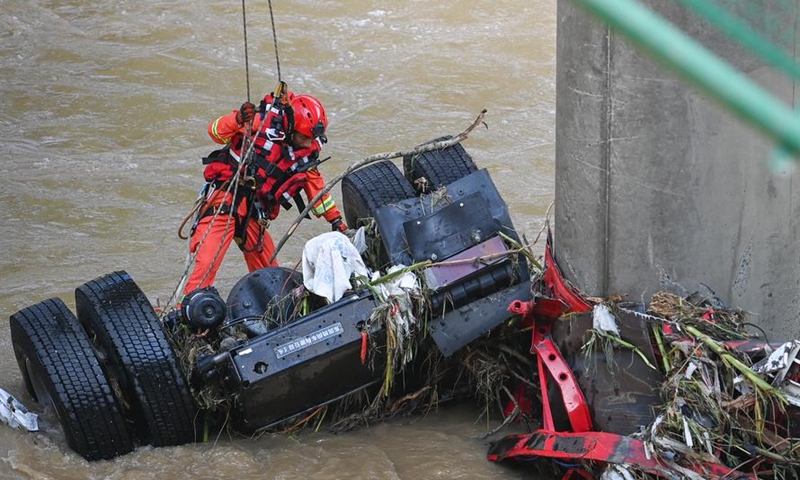Authorities order all-level disaster response to enter critical operations during peak flood season
Extreme weather events caused by climate change raise urgency of reassessing risk control, infrastructure maintenance: experts

A rescuer works at the site of a bridge collapse in Zhashui County in Shangluo City, Northwest China's Shaanxi Province, July 21, 2024. Photo: Xinhua
Chinese authorities on Sunday instructed all-levels of the flash flood disaster response system to enter critical flood control operations following the bridge collapse in Northwest China's Shaanxi causing 15 deaths, and a sudden flash flood due to heavy rainfall in Southwest China's Sichuan leading to 10 deaths.
President Xi Jinping has urged all-out rescue and relief efforts to safeguard people's lives and property after the collapse of the bridge.
On Saturday, Vice Premier Zhang Guoqing led a working team to the site in Zhashui county to guide rescue efforts. Zhang stressed that as the current flood season features high risks of geological disasters, all regions should comprehensively investigate and rectify potential risks along highways and railways.
Meanwhile, authorities have initiated national road hazard inspections, aiming to leave "no blind spots" during the country's peak flood season.
Given that global climate change is leading to an increase in extreme weather events worldwide including high temperature, heatwaves, wildfires and floods, some experts called on reassessing the risks management system and raising standards for infrastructure construction and maintenance, especially in areas prone to heavy rain, flash flooding and mudslides.
The bodies of 15 people had been recovered as of 7 pm Sunday, according to the Xinhua News Agency, after the partial collapse happened to a bridge of the Danning Expressway connecting Danfeng and Ningshan counties of Shaanxi due to heavy rainstorms and flash flooding.
At Sunday noon, it had been initially confirmed that 25 vehicles fell off the bridge, with 43 people inside.
The localities of some of the vehicles that fell into the river have been identified as of press time on Sunday, according to media reports. Firefighters have been working with professional underwater divers to attempt to enter the vehicles and search for missing people.
The Ministry of Water Resources mandated the immediate closure on Sunday of all reservoirs on the main and tributary streams upstream of the collapsed bridge on the Jinqian River to create favorable conditions for rescue operations.
A local Zhashui resident told the Global Times on Sunday that the rain has stopped, and the floodwaters have receded somewhat on Sunday. "But the impact on people's lives is significant, as the power grid has been severely damaged by the disaster, leading to a complete system-wide outage," she said, noting that she has not been able to contact other family members so far.
A video that was posted on Douyin, the Chinese version of TikTok, on Sunday showed that the floodwaters surged through a local village in Zhashui, and several cars were swept away by the flood.
Following the collapse of the bridge, emergency road hazard inspections have been initiated in multiple regions nationwide. Local authorities in places such as North China's Hebei urged daily monitoring and patrols in high-traffic highway sections, using weather monitoring and early warning systems.
Local authorities are also being encouraged to use intelligent monitoring technologies, such as ground-penetrating radar and drones to achieve real-time monitoring as soon as possible.
In Sichuan, a sudden flash flood began in the night around 2:30 am on Saturday triggered by heavy rainfall in a village in Ya'an has caused 10 deaths and left 29 people missing, as of 4 pm Sunday. Fifteen people were injured in the accident, with five people already released from hospital, and a total of 412 impacted residents have been safely relocated.
Flash flooding began at around 2:30 am in Xinhua village in Hanyuan county on Saturday, and some local villagers were quoted as saying in media reports that many people were asleep at the time and couldn't escape.
A local official from the emergency management bureau in Hanyuan county told the Global Times on Sunday that the access to the affect areas has been made available but communication can only be guaranteed in some areas. Due to severe and ongoing rain, the fiber optic connections in the disaster area have been washed away, rendering communication difficult in a number of areas.
"Local authorities have always been committed to responding to rainstorms. It is just that the conditions in the areas hit by the storm this time were rather unexpected and had not been encountered in 100 years," the unnamed official said.
As for the relief materials, the official noted that the supplies applied for on Saturday have already been transferred to the affected areas. Some supplies have also been granted by the relevant authorities and are on their way.
"We need to take some of the risks caused by climate change seriously and acknowledge that some of our existing understandings may need to be reassessed, which also involves reevaluating those risks," Ma Jun, director of the Beijing-based Institute of Public and Environmental Affairs, told the Global Times on Sunday.
"We may need to raise our design standards and improve our construction practices as well as the operation and maintenance of infrastructure," Ma said, noting that improving forecasting, monitoring and early warning system is essential for places prone to disasters.
Li Yawei also contributed to the story